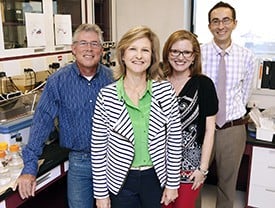UAMS Researchers Help Discover Genetic Key to Food Allergy Condition
| 
UAMS allergy researchers (l-r) Richard Kurten, Ph.D., Stacie Jones, M.D., Amy Scurlock, M.D., and Robert Pesek, M.D., helped achieve a breakthrough in a rare allergic disorder.
Sept. 9, 2014 | A recent breakthrough in understanding the cause of a rare, hard-to-treat allergic disorder has been made by a group of research institutions that include the University of Arkansas for Medical Sciences (UAMS) and the Arkansas Children’s Hospital Research Institute (ACHRI).
The discovery, reported online in Nature Genetics, could lead to new targeted therapies for eosinophilic eophagitis (EoE). The allergic/immune condition causes inflammation of the esophagus, usually from consuming foods such as dairy products, eggs, soy and wheat.
The condition can cause infants and toddlers to refuse food and hinder their development. Older children may have recurring abdominal pain, vomiting and trouble swallowing, while teenagers and adults typically have difficulty swallowing. Food may also become stuck in the inflamed esophagus, creating a medical emergency.
Existing treatments for EoE are limited to prescribing long-term restrictive diets and steroid sprays to swallow.
“We hope this discovery will open the door to some additional treatment options,” said Stacie Jones, M.D., a professor in the departments of Pediatrics and Physiology & Biophysics in the UAMS College of Medicine. She is also section chief of Allergy & Immunology and leads the allergy research team ACHRI.
The study found that EoE is triggered by the interaction between epithelial cells, which help form the lining of the esophagus, and a gene called CAPN14. It also identified a marker that can be used to measure the activity of the disease, said UAMS’ Robert Pesek, M.D., an author on the study and an assistant professor in the Department of Pediatrics in the UAMS College of Medicine.
“Currently, the only tool we have for measuring that is endoscopy, and that becomes impractical for repeated use on children,” Pesek said.
Although new treatments have yet to be realized, UAMS’ participation in EoE and other food allergy research gives Arkansas patients access to cutting-edge research and treatment expertise not available anywhere else in the state.
“This work brings patients into a larger clinical trial network for their disease,” said Jones, who also leads the group in its work with a national consortium of institutions conducting groundbreaking peanut allergy research. “It brings very high-profile work on a rare disease to our institution and to our patients and families who otherwise would have to travel extensively to get the same benefits of research.”
The EoE findings, which included genomic and protein analyses of 736 patients who participated in the research, give researchers a better understanding of why people develop EoE disorders and allergies in general.
A multidisciplinary EoE clinic was established in 2011 at Arkansas Children’s Hospital and is staffed by UAMS allergy specialists, gastroenterologists, and nutrition and counseling providers. More than 100 patients seen at the EoE Clinic participated in the study.
“This discovery would not have been possible without the contributions of our patients,” Jones said. “We are grateful to all of those who participate because they are responsible for helping us find and improve treatments for EoE and food allergies.”
Pesek, the EoE Clinic medical director, said the findings may also lead to more efficient, less traumatic ways of diagnosing patients than endoscopy and biopsy of the esophagus.
The study was led by a team at Cincinnati Children’s Hospital in collaboration with UAMS and Arkansas Children’s Hospital; Icahn School of Medicine at Mount Sinai, New York.; Johns Hopkins University School of Medicine, Baltimore; University of North Carolina, Chapel Hill, North Carolina; National Jewish Health, Denver; and The EMMES Corporation, Rockville, Maryland.
The study received major funding from the National Institutes of Health (NIH), with support from Food Allergy Research & Education (FARE) and other organizations.
The UAMS Translational Research Institute provides nursing and nutritional support to food allergy research at ACHRI.
UAMS is the state’s only comprehensive academic health center, with colleges of Medicine, Nursing, Pharmacy, Health Professions and Public Health; a graduate school; a hospital; a statewide network of regional centers; and seven institutes: the Winthrop P. Rockefeller Cancer Institute, the Jackson T. Stephens Spine & Neurosciences Institute, the Myeloma Institute for Research and Therapy, the Harvey & Bernice Jones Eye Institute, the Psychiatric Research Institute, the Donald W. Reynolds Institute on Aging and the Translational Research Institute. It is the only adult Level 1 trauma center in the state. UAMS has more than 2,865 students and 785 medical residents. It is the state’s largest public employer with more than 10,000 employees, including about 1,000 physicians and other professionals who provide care to patients at UAMS, Arkansas Children’s Hospital, the VA Medical Center and UAMS regional centers throughout the state. Visit www.uams.edu or uamshealth.com.
ACHRI provides a research environment on the ACH campus to meet the needs of the UAMS faculty. Research scientists at ACHRI conduct clinical, basic science, and health services research for the purpose of treating illnesses, preventing disease and improving the health of children everywhere.